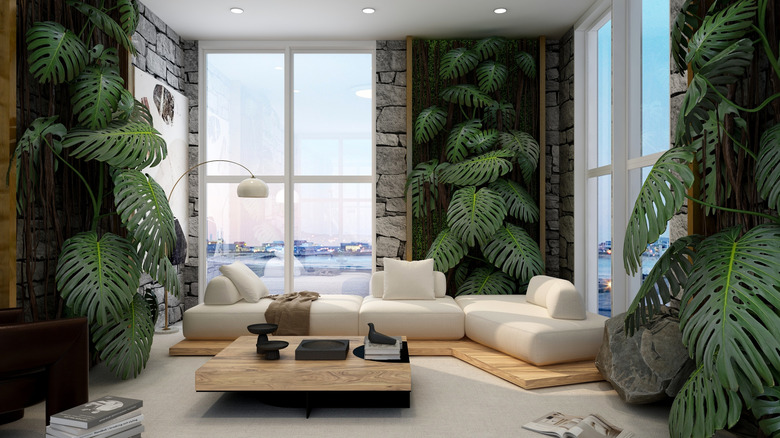Make Your Home Decor More Eco-Friendly With Vegan Interior Design
Plant-based and cruelty-free aren't bad tenets to live by. Traditionally, these terms refer to diet or personal care that doesn't involve animal products or animal testing. But what is vegan interior design? Strictly speaking, vegan design doesn't use any animal-based products. This includes wool, leather, feathers and down, silk, bone, and beeswax.
It's becoming a trend to broaden veganism into other aspects of life, and vegan design is a thoughtful way to make your home more eco-friendly. Just as the diet does, incorporating vegan design into your lifestyle greatly reduces the amount of resources that go into producing raw material. A UK study concluded that the production of plant-based foods is 75% less damaging to the climate than animal-based products, making vegan diets more beneficial for the environment as less animal-based food is produced. It stands to reason that producing furniture, paint, and other home products that contain animal products could also be more damaging to the environment, so plant-based vegan design options could be a better choice for the environment as well.
In keeping with the environmental theme, vegan design often strays beyond the lines of avoiding just animal-based products. This design principle often promotes using low- to no-toxin and sustainable materials. There are plenty of ways to incorporate these principles into your own home, no matter what your budget is.
Invest in vegan design
Not every piece of furniture or decorative element shows its animal origins. It's a given that a leather couch isn't the best fit for vegan design, but the pre-consumer life of many products is said to make things like fabrics, paint, and upholstery components incompatible with vegan design. Animal byproducts could be used in paints or dyes, for example. Enlisting a vegan designer to help you source cruelty-free pieces and products is a brilliant idea, but it doesn't fit everyone's budgets. Luckily, you can achieve vegan design on your own once you know what to look for.
While the first thought that comes to mind with vegan design is what not to use, there are elements you can gravitate toward. Natural, plant-based fibers like bamboo, cork, and organic cotton and hemp cloth all play a significant role in vegan design since they are durable and biodegradable. Think about what goes inside items as well — seek out pillows, bedding, and upholstered furniture that isn't stuffed with down, for example.
Choosing as many second-hand furnishings and accessories as possible is a way to follow vegan design principles without the high price tag. Give thrifting home decor a try, and help save billions of pounds of potential waste from landfills each year. Shop from home by hitting up sites like Etsy, Ebay, Craigslist, and Facebook Marketplace. Even Poshmark, a site usually associated with clothes, can be a source of amazing second hand furnishings.
What to watch out for with vegan design
We are used to checking food labels to see what we're ingesting, but with interior decorating, the ingredients aren't often 100% clear. You may not know that house paints are typically tested on animals and often contain animal ingredients. Your wall color might have milk products or even bones in the mix. Some textile dyes are made from animal byproducts, and many — including synthetic or plant-based dyes — are tested on animals. There are several vegan textile certifications that you can look for before making purchases.
Be warned: Lots of products that wear a "vegan" label don't necessarily mesh with sustainable interior decor. Low-cost vegan leather substitutes are often plastic-based, and this is far from eco-friendly. These types of imitation leather are often a byproduct of the petroleum industry, and most faux leather material is made in China. This also raises concerns about energy consumption for transporting the items as well as the emissions from producing new goods.
In general, vegan design avoids all animal-derived products. However, some vegans blur the lines by still buying non-vegan items but only purchasing them second-hand; the argument is that no additional harm to an animal or the planet was done for this leather, wool, silk, or fur piece. While this is a personal decision, you may feel more at ease buying a pre-owned leather sofa or wool rug if you prefer those products.


